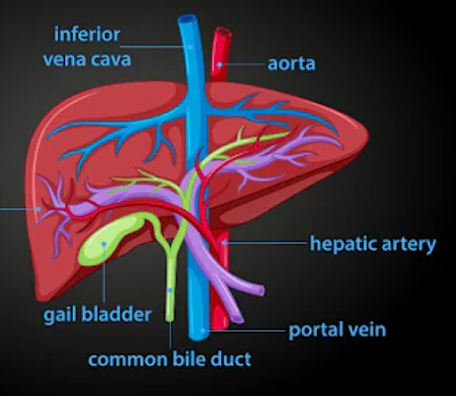About of Liver :
The largest organ and the largest gland in our body called liver. Liver is located in the upper right hand person of the abdominal Cavity.15-22 cm In it's dimensions and weight about 1.5 kg.
It is dark reddish-brown in color and lies just
beneath the diaphragm more towards the ride side of abdomen.The liver is
divided into two main lobes join together falciform ligament.
Each liver lobe is made of a number of smaller
lobules covered by a thin layer of connective tissue called Glisson’s
capsules.Lobules structural and functional units of liver.Human liver is
four lobed.The hepatic artery and the hepatic portal vein bring the blood
to the liver which is drained into the inferior vena cava by hepatic
vein.On the under surface of the liver lies a pear shaped gall bladder
which is about 10-15 cm long and 2.5 cm wide.It serves as reservoir for bile
which is secreted in the liver.Liver cells secrete bile into bile ductules
which in turn open into hepatic ducts.The hepatic duct from liver
and cystic duct from the gallbladder join to form a common bile duct.About
600-1000 ml of bile is secreted by liver everyday.
Important liver functions is below:
- Secretion of liver is bile.its a dark green
color alkaline fluid consisting of bile salts,bile pigment.cholesterol
etc.
- Renders chyme alkaline for action of pancreatic
juice.
- It brings about emulsification of fats.
- Helps in removal of excretory products such as
bile pigments,inorganic salts,toxin etc.
- It stimulates peristalsis.
- Liver synthesizes various enzymes,vitamins and
lymph.
- It stores vitamins,glucose,inorganic salts of
iron and copper,and ribonuclcoproteins.
- It produces red blood cells in embryos.
- Liver sinusoids act as blood reservoirs.
- Lymph formation also occurs in liver.
- It helps in glycogenesis and glycogenolysis.
- It checks anaemia and regulates bodyheart.
- Clearing the blood of drugs and other poisonous
substances.
- Bile salts help in absorption of fat soluble vitamins
like ‘K’.
- liver is the most important organ for metabolism in vertebrates.





.png)

%20(1).png)
